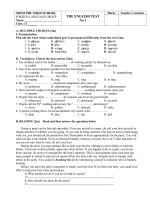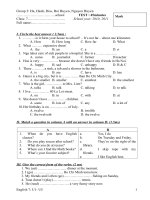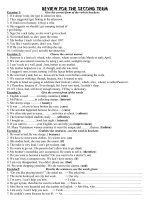45’ Test No 1 pptx
Bạn đang xem bản rút gọn của tài liệu. Xem và tải ngay bản đầy đủ của tài liệu tại đây (19.9 KB, 4 trang )
45’ Test No 1
Name: __________________________________
Class: 12A_______________
A . Phonetics ( 1m )
Choose the word that has the underlined part pronounced differently from that of the others
1.A . played B . cooked C. talked D. laughed
2. A. roofs B. boards C. hangs D. clothes
3. A. watches B. trees C. buses D. sentences
4. A. hanged B. earned C. noted D. cleaned
B. Grammar and structures
I. Choose the correct answer (4m)
1. Peter lives with his parents and two sisters. There are __________ generations in his
family.
A. 2 B. 3 C. 4 D. 5
2. In America, it isn’t ___________to ask personal questions.
A. polite B. impolite C. rude D. B&C are
correct
3. Why don't you make it bigger and more colourful to ________ people's attention ?
A. keep B. idea C. attract D.
raise
4. If you are walking in the schoolyard and see your teacher approaching you, a small
friendly wave is appropriate
A. greeting B. waving at C. coming near D.
following
5. We can raise our hand slightly to show that we need assistance .
A. help B. attention C. communication D.
food
6. We can use verbal or nonverbal forms of communication .
A. using verbs B. using speech C. using gesture D.
using facial expression
7: This is the second time ___________.
A. you've lost your door key
B. you are losing your door key
C. you were losing your door key
D. your door key was lost by you
8. He __________ his job last month and since then he __________ out of work.
A. lost – has been B. lost – was C. has lost - was D. was lost –
has been
9. Come and see me when you __________ your report.
A. finish B. will finish C. had finished D. finished
10. I __________ much of you lately. We __________ three months ago.
A. haven’t seen – have met B. didn’t see – have met C. haven’t seen – last met
D. didn’t see – met
11. By the time we got to the party, they … everything.
A. were eating B. have eaten C. had been eaten
D. had eaten
12. John … his first piece of music when he was 10 years old.
A. writes B. wrote C. written
D. was writing
13.When I came to visit him last night, he ______ his homework. He said that he
_________ it since 6 o’clock.
A. did/did B. was doing/was doing C. was doing/has been doing D. was
doing/had been doing
14. Max told me _______ a book in the evening .
A. if he often reads B. he has often read C. that he often read D. he
was reading
15. When I _________ this morning , my roommate ______ already .
A. am waking / leaves B. wake / has left C. was waking / left D. woke
/ had left
16. She said she _______ .
A. was very tired last night B. was very tired the night before
C. had been very tired last night D. had been very tired the night
before
II . Choose the underlined part need correcting ( 1m)
17. Mike told that he was leaving the next day , not then .
A B C D
18. He wondered whom had put salt in his coffee .
A B C D
19. It’s the first time I saw this film.
A B C D
20. It took him only thirty minutes to go to school every day by bicycle.
A B C D
C. reading ( 1m)
Movements and gestures by the hands, arms, legs, and other parts' of the body and
face are the most pervasive types of nonverbal messages and the most difficult to control.
'It is estimated that there are over 200.000 physical signs capable of stimulating meaning
in another person. For example, there are 23 distinct eyebrow movements, each capable
of stimulating a different meaning.
Humans express attitudes toward themselves and vividly through body movements
and postures. Body movements express true messages about feelings that cannot be
masked. Because such avenues of communication are visual, they travel much farther
than spoken words and are unaffected by the presence of noise that interrupt, or cancels
out speech.
People communicate by the way they walk, stand, and sit. We tend to be more
relaxed with friends or when addressing those of lower status. Body orientation also
indicates status or liking of the other individual. More direct orientation is related to a
more positive attitude.
Body movements and postures alone have no exact meaning, but they can greatly
support or reject the spoken word. If these two means of communication are
dichotomized and contradict each other, some result will be a disordered image and most
often the nonverbal will dominate.
1. Which part of body is not used to send body message?
A. stomachs B. legs C. hands
D. faces
2. Face gestures ________.
A. cannot express our feelings B. are the most difficult to control
C. can help us control our feelings D. do not include eye brow moments
3. According to the text, body movements cannot express ________.
A. status B. feelings C. attitudes D.
desires
4. Nonverbal communication ________.
A. dominates words B. has no relation to verbal
communication
C. may be interrupted by noise D. is less common than
verbal communication
D . (3m)
I . Put the verb in bracket into correct tense
1. Somebody (steal) my bicycle l Now I '11 have to walk
home.
2. Gerry (fall) off his bike three times this month.
3. Martin (graduate) from university last July.
4. Look at those black clouds. It (rain)
5. Noone ( use) this car for several years.
6. The door won't open unless you (push) it hard.
II. Report the following sentences
1.“ Would you like to go camping with us next weekend?” said Minh to Phong.
2.“If I were you, I would join the voluntary team tomorrow, Tom.” said Mike.
3. “ What do you usually do in your free time ?” the examiner asked .









